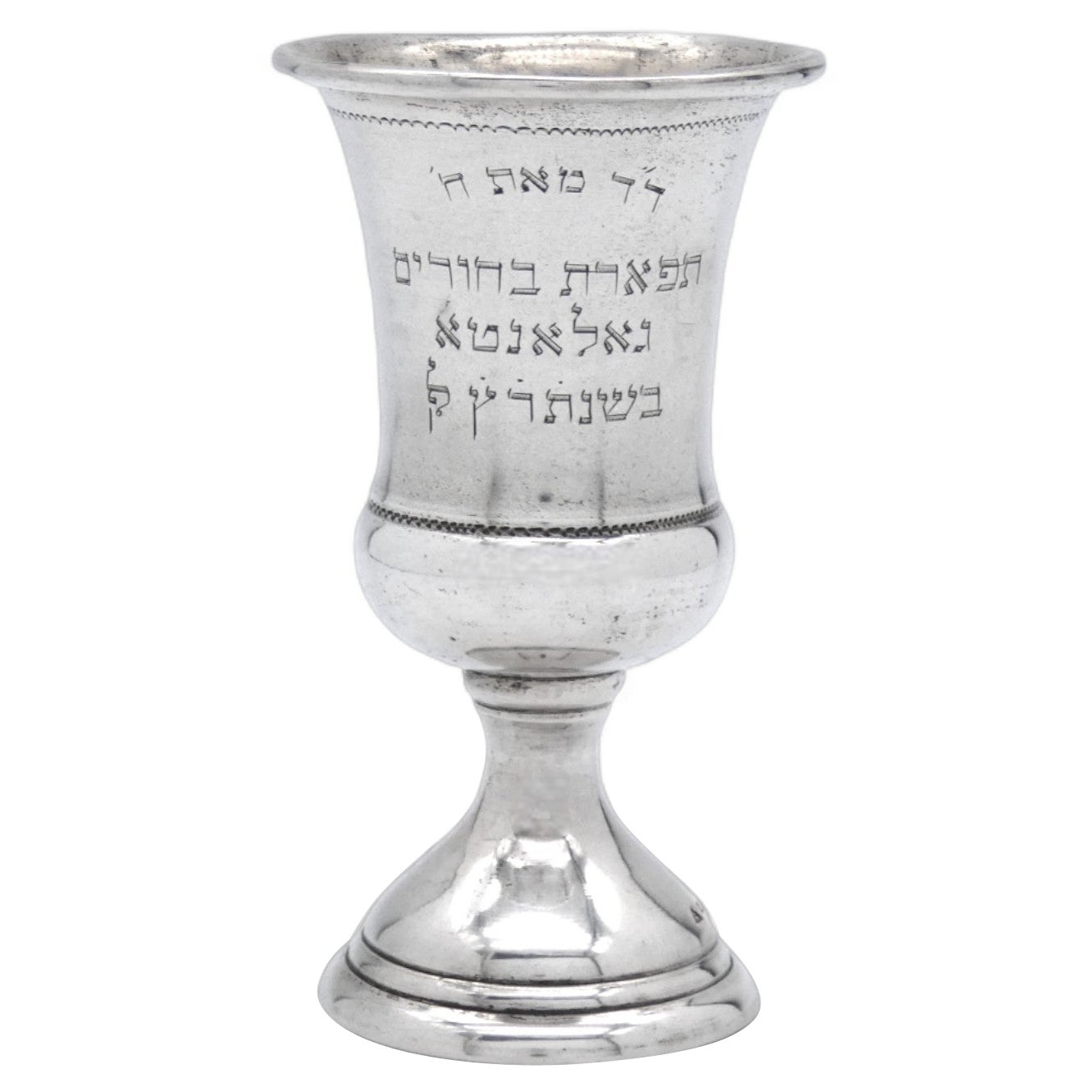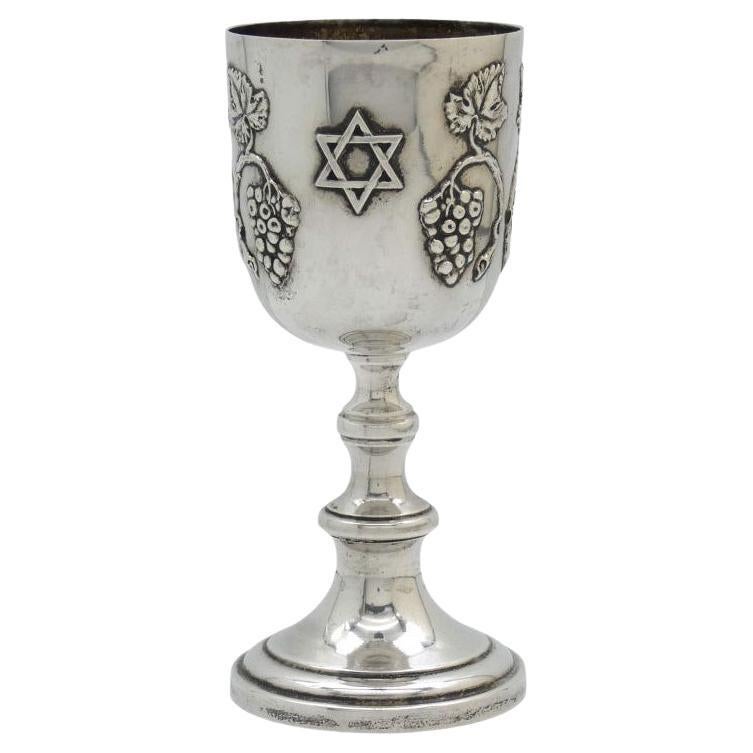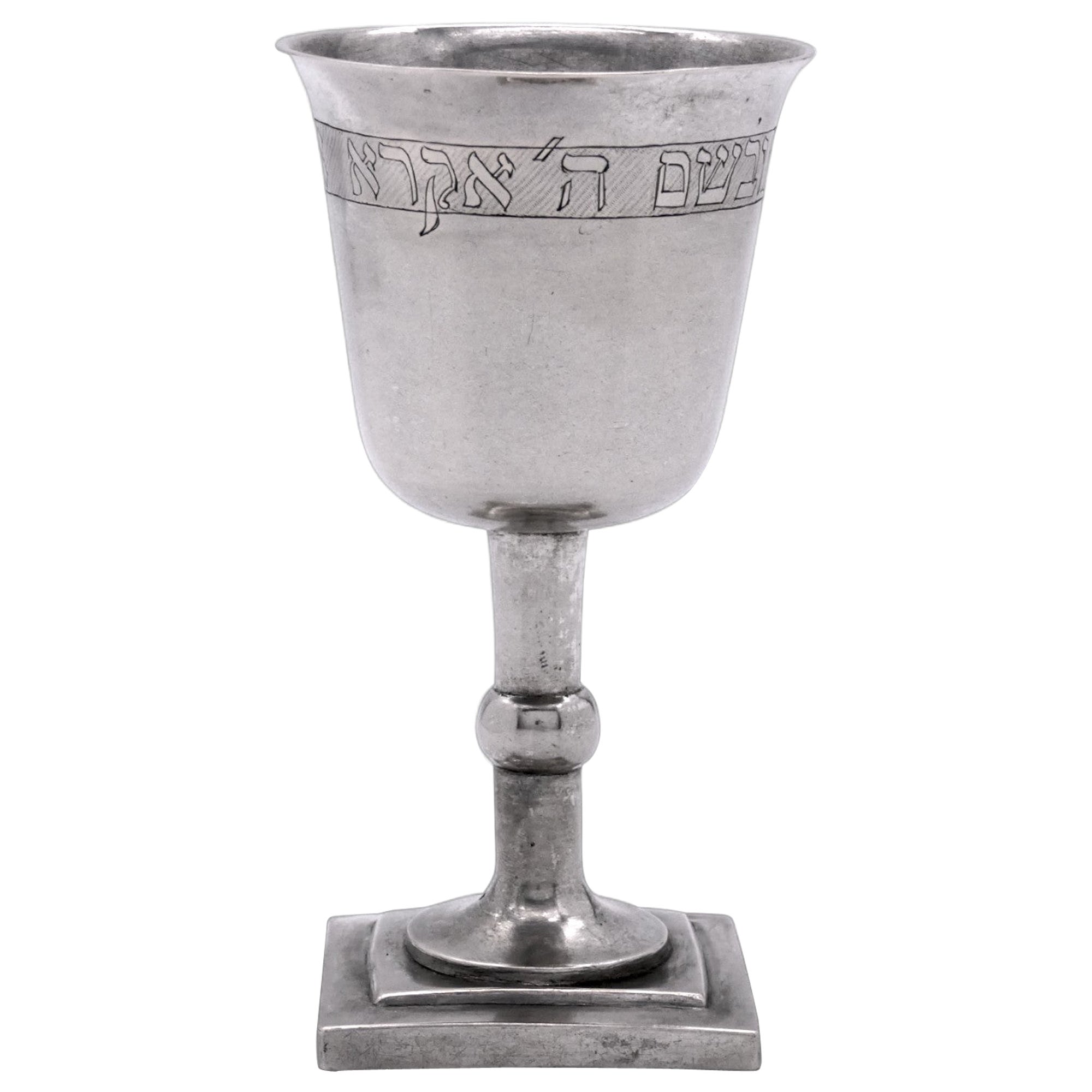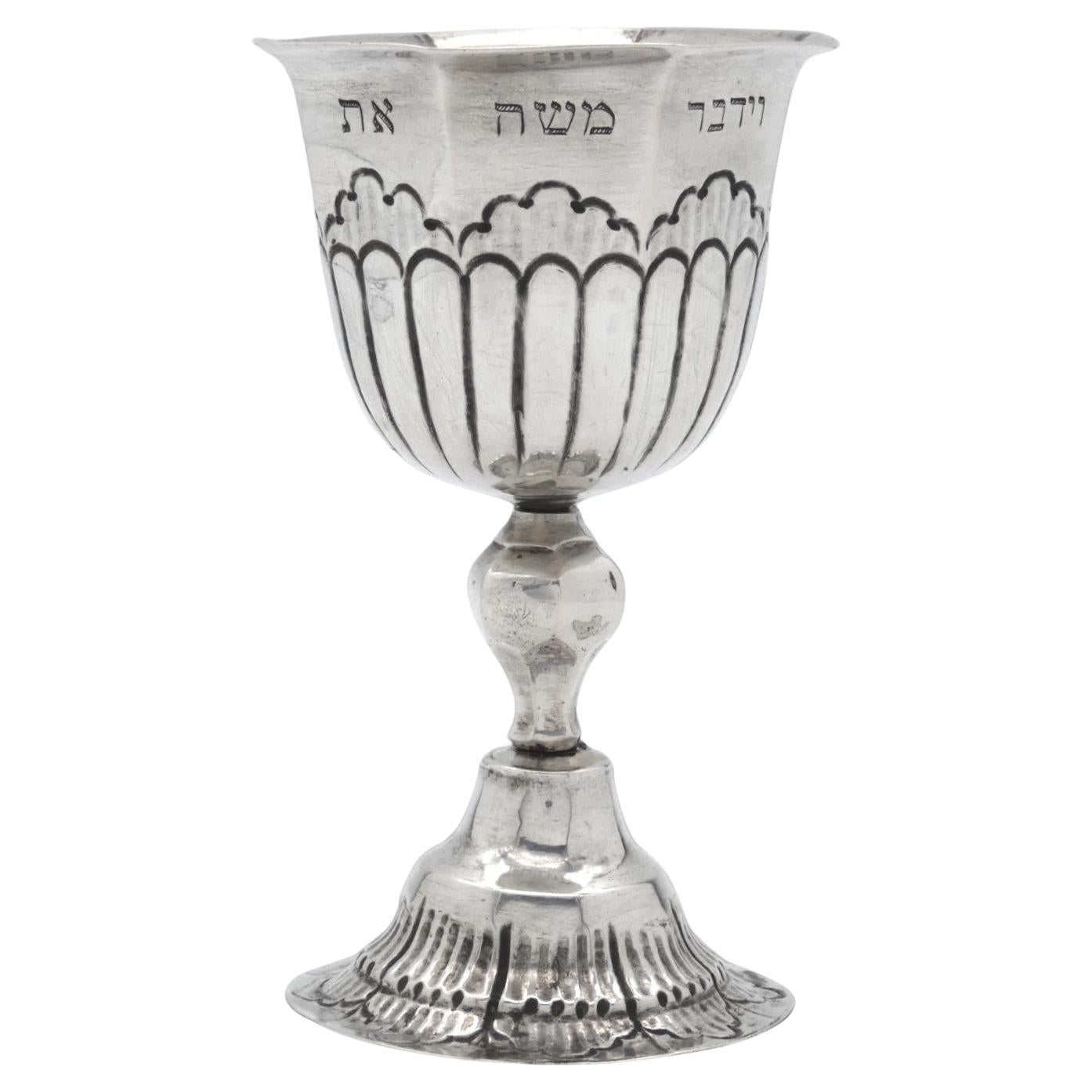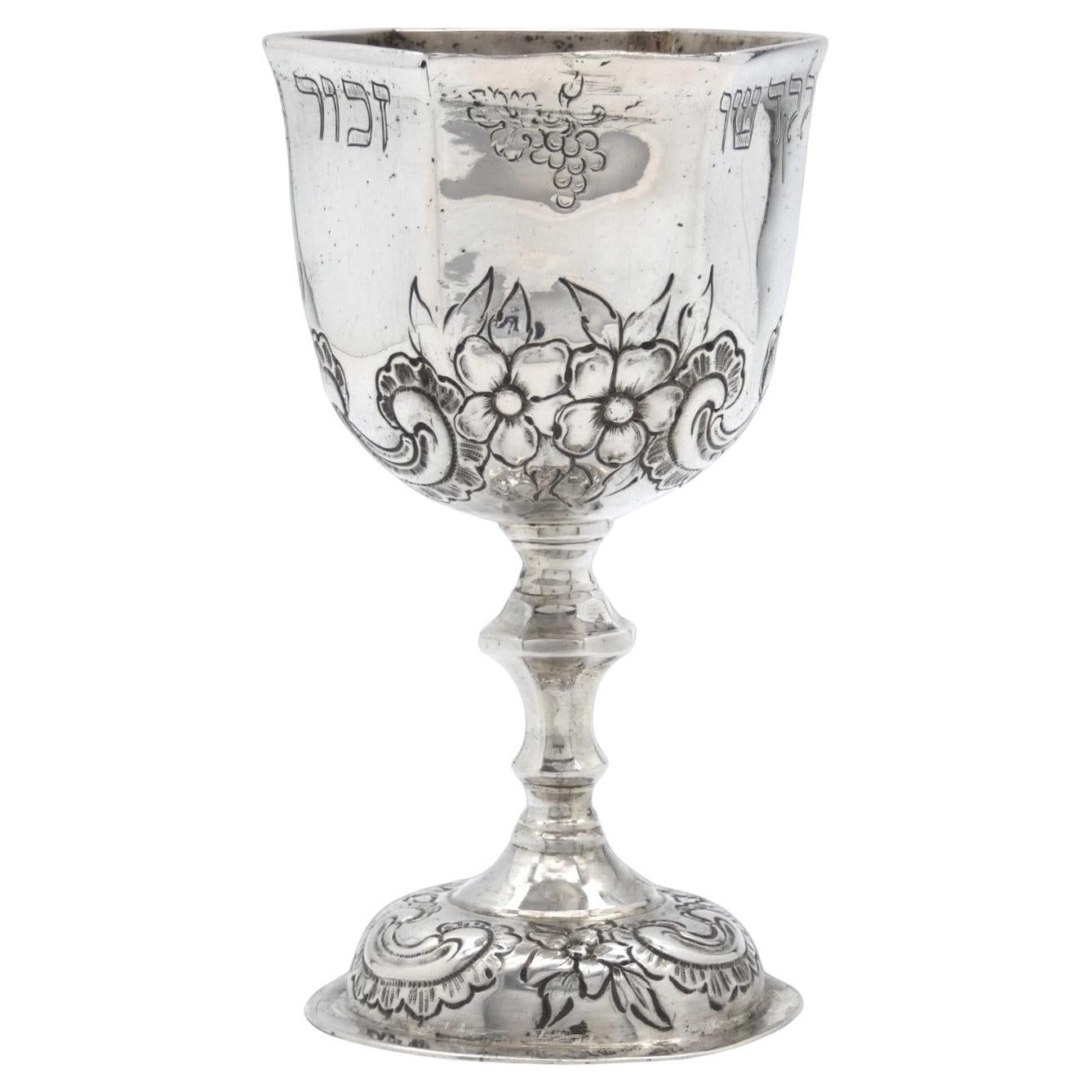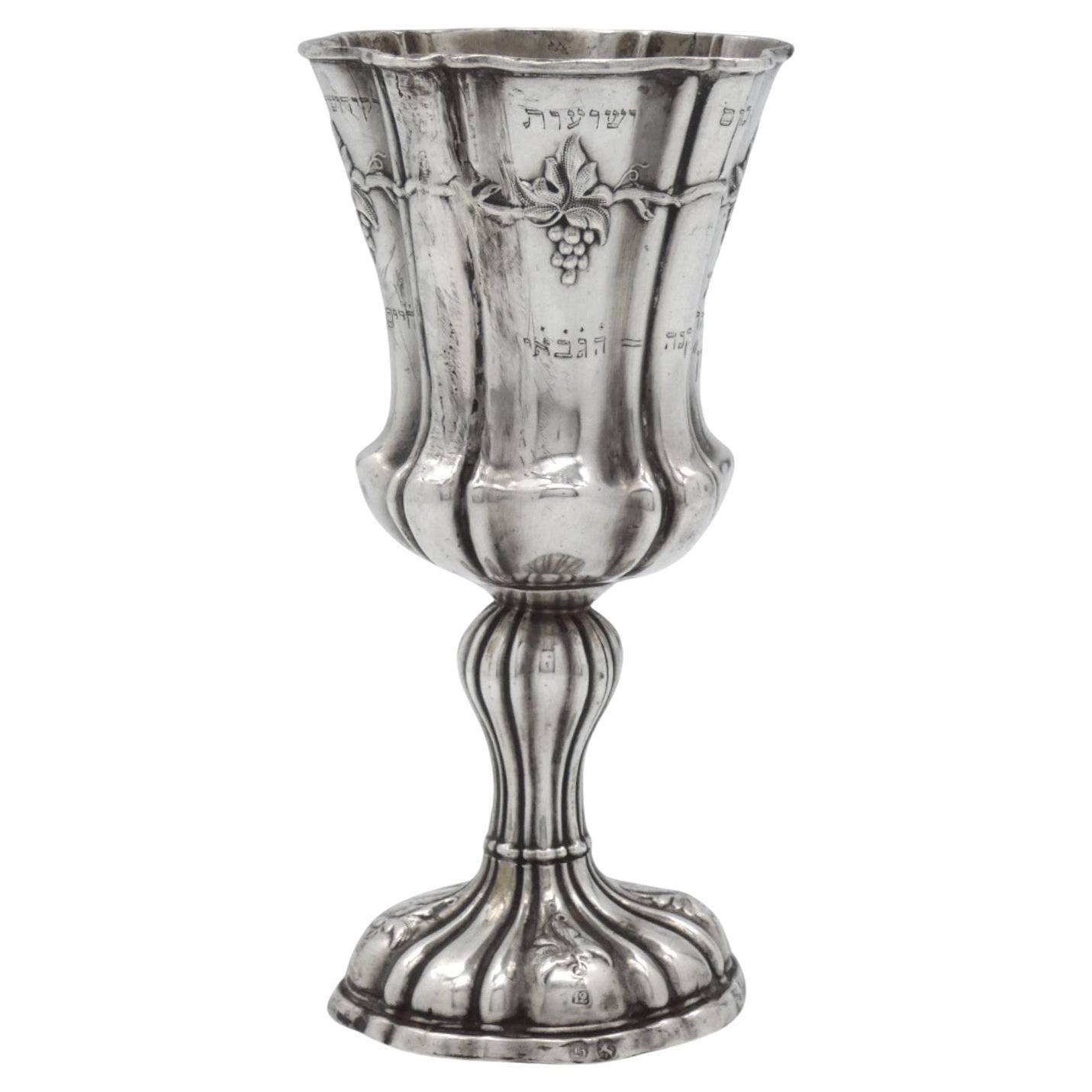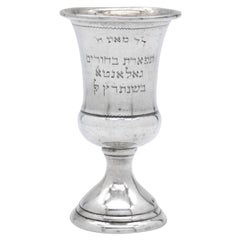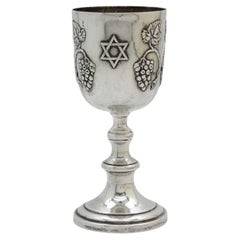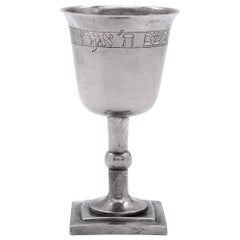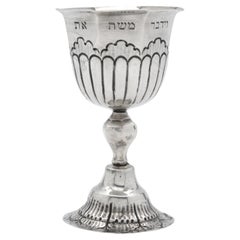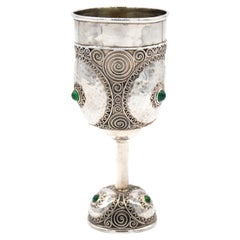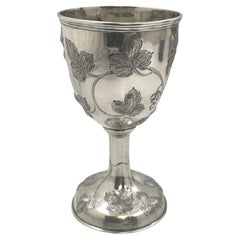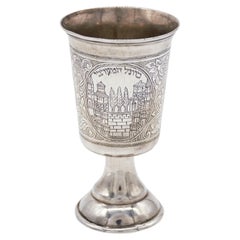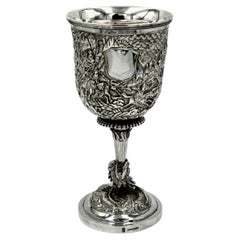Items Similar to An American Silver Kiddush Goblet, Newburgh NY 1937
Want more images or videos?
Request additional images or videos from the seller
1 of 8
An American Silver Kiddush Goblet, Newburgh NY 1937
$1,600
$2,00020% Off
£1,206.56
£1,508.2020% Off
€1,395.44
€1,744.3020% Off
CA$2,244.79
CA$2,805.9920% Off
A$2,495.23
A$3,119.0320% Off
CHF 1,307.94
CHF 1,634.9320% Off
MX$30,472.74
MX$38,090.9220% Off
NOK 16,328.92
NOK 20,411.1520% Off
SEK 15,362.47
SEK 19,203.0920% Off
DKK 10,415.18
DKK 13,018.9820% Off
About the Item
An American silver Kiddush goblet from Newburgh, NY, dated 1937 and dedicated by the Hebrew Transient Organization of Newburgh to a dedicated patron, is an intriguing piece of Judaica with historical and cultural significance.
The Hebrew Transient Organization of Newburgh assisted Jewish transients or immigrants in need during the 1930s. Such organizations were vital during this period, offering support and community services to those struggling during the Great Depression and other challenging times. Newburgh had a notable Jewish community that contributed to local culture and social support systems. This goblet serves as a historical artifact reflecting the community's efforts to aid and integrate Jewish transients and immigrants.
The dedication reads in English on one side: "Presented to William Becker by the Hebrew Transients Org. of Newburgh N.Y. 1937. On the other side in Yiddish: "Presented to R' Zev Becker for Invaluable work in favor of the Hospitality to Guests in Newburgh N.Y. 1937.
The tulip-shaped goblet's surface is smooth and is set on a round conical-shaped base and connecting stem with a round-banded inner lip.
This silver Kiddush goblet is more than a ceremonial object; it represents the resilience and solidarity of the Jewish community in Newburgh during the 1930s. Given its specific dedication and the historical context, the goblet is a rare collectible. Its connection to the Hebrew Transient Organization provides valuable insights into the support networks within Jewish communities during the early 20th century.
Marked under the goblet's base.
4.2ozt.
- Dimensions:Height: 6.38 in (16.2 cm)Diameter: 3.51 in (8.9 cm)
- Materials and Techniques:Silver,Engraved
- Place of Origin:
- Period:
- Date of Manufacture:1937
- Condition:Wear consistent with age and use.
- Seller Location:New York, NY
- Reference Number:1stDibs: LU5281240073892
About the Seller
5.0
Recognized Seller
These prestigious sellers are industry leaders and represent the highest echelon for item quality and design.
Established in 2006
1stDibs seller since 2020
134 sales on 1stDibs
Typical response time: 8 hours
- ShippingRetrieving quote...Shipping from: Pomona, NY
- Return Policy
Authenticity Guarantee
In the unlikely event there’s an issue with an item’s authenticity, contact us within 1 year for a full refund. DetailsMoney-Back Guarantee
If your item is not as described, is damaged in transit, or does not arrive, contact us within 7 days for a full refund. Details24-Hour Cancellation
You have a 24-hour grace period in which to reconsider your purchase, with no questions asked.Vetted Professional Sellers
Our world-class sellers must adhere to strict standards for service and quality, maintaining the integrity of our listings.Price-Match Guarantee
If you find that a seller listed the same item for a lower price elsewhere, we’ll match it.Trusted Global Delivery
Our best-in-class carrier network provides specialized shipping options worldwide, including custom delivery.More From This Seller
View AllA Silver Kiddush Goblet, Hungary Circa 1930
Located in New York, NY
A Dedicated Silver Kiddush Goblet, made in Hungary Circa 1930.
Seemingly this Kiddush Goblet was donated pre-WWll by a youth group in Galanta which at that time was part
of Hungary...
Category
Early 20th Century Hungarian Sterling Silver
Materials
Silver
$2,800 Sale Price
20% Off
A 20th Century American Silver Kiddush Goblet
Located in New York, NY
This elegant 20th-century American silver Kiddush goblet is a striking example of refined Judaica design, blending traditional Jewish symbolism with classic American silversmithing o...
Category
20th Century American Sterling Silver
Materials
Sterling Silver
A Silver Kiddush Goblet, Poland mid 19th Century
Located in New York, NY
A Refined Silver Kiddush Goblet, made in Poland in the mid-19th Century.
This Polish Kiddush Goblet has an interesting feature about it. On the upper body, there is a Hebrew verse e...
Category
Antique Mid-19th Century Polish Sterling Silver
Materials
Silver
$4,000 Sale Price
20% Off
A Silver Kiddush Goblet, Germany 18th Century
Located in New York, NY
An Important Silver Kiddush Goblet made in Germany in the 18th Century.
Goblet rests on a circular domed base with floral scrolling encircling the base.
Knopped trophy stem support...
Category
Antique 18th Century German Sterling Silver
Materials
Silver
$5,200 Sale Price
20% Off
A Silver Kiddush Goblet, Germany 19th Century
Located in New York, NY
A Lovely Silver Kiddush Goblet made in Germany in the 19th Century
Kiddush Goblets such as these were fairly common in many households in Germany during the 19th century.
Kiddush G...
Category
Antique 19th Century German Sterling Silver
Materials
Silver
$1,600 Sale Price
54% Off
A Silver Kiddush Goblet, Austria Circa 1860
Located in New York, NY
A Fancy Silver Kiddush Goblet, made in Austria Circa 1860.
Kiddush Goblet is uniquely designed as this kiddush has no distinct shape and has distinctive ridges running across the le...
Category
Antique Mid-19th Century Austrian Sterling Silver
Materials
Silver
$4,800 Sale Price
20% Off
You May Also Like
Important Early 20th Century Silver Kiddush Goblet by Bezalel School Jerusalem
Located in Tel Aviv - Jaffa, IL
Important Handmade sterling silver Kiddush goblet by Bezalel School, Jerusalem, circa 1910-1913.
On round base decorated with silver filigree and Cabouchon shaped green agate applications.
The base fitted with Bezalel mark. The upper portion is all adorned with amazing filigree work, the base and the actual cup adorned with swirling filigree designs, in the middle there are 3 roundels, made in another technique of hammered silver, similar to the works that were produced in this time all over Europe, in the middle of each roundel there is a perfectly centered Cabouchon green agate.
This work is attributed to Yehia Yemini.
The goblet is marked on the base, with the earliest silver mark of the school that just say "Bezalel" in Hebrew.
Yehia Yemini :
Was one of the biggest and must famous Bezalel silver...
Category
Early 20th Century Israeli Jugendstil Sterling Silver
Materials
Silver
Eben Cutler Coin Silver Goblet/ Kiddush Cup from 19th Century
Located in New York, NY
Eben Cutler, coin silver goblet from the 19th century adorned with vine-like motifs, faintly gilt inside. It measures 6 1/8'' in height by 3 1/2'' i...
Category
Antique 19th Century American Sterling Silver
Materials
Silver
Rare "Safed" kiddush cup, late 19th century Poland/ Eretz ISRAEL
Located in Tel Aviv - Jaffa, IL
This 84 silver cup was made in Europe, in Poland or parts of Poland that are in modern Russia in the 19th century, the interesting and important in this cup types is that they were s...
Category
Antique 1890s Israeli Sterling Silver
Materials
Silver
Chinese Export Silver Goblet
Located in London, GB
A rare Chinese Export Silver Goblet depicting the story of the Three Kingdoms. The goblet embossed and chased with characters of army of General Dian Wei (典韦) and General Lü Bu (吕布)....
Category
Antique 1870s Chinese Chinese Export Sterling Silver
Materials
Silver
$10,347
Antique Portuguese Goblet Cup solid 833 Silver / 173 gr
Located in SE
Antique Portuguese Silver Cup, thick walled, with continuous cast floral ornaments and well preserved internal gilding.
This cup has a set of small sized conventional Portuguese ha...
Category
Vintage 1920s Portuguese Renaissance Revival Barware
Materials
Gold Plate, Silver
A RARE SILVER SHMIROT KIDDUSH CUP. Galician, c. 1850.
Located in Tel Aviv - Jaffa, IL
A RARE SILVER SHMIROT KIDDUSH CUP. Galician, c. 1850.
Among some Hassidic courts, it was a practice for the Rabbi to give a blessed silver coin to his Hassidim as an amulet. Such protection might be given for all manner of life events, from healing from an illness to success in travel and the amulet was carried on the body of the recipient. This custom was particularly popular among the Ryzhiner Hassidim and these coins were called "Shmirot". To such coins were attributed extraordinary power and value and they were treasured with great care and love.
this cup is marked with polish loth 12 mark which indicate silver content of 75%.
Size :
Height 2.3 inch / 6 cm
Width : 2 inch / 5 cm
After the specific event for which they had originally be given, such a coin or coins were used in the making of other objects, which maintained the special aura of the Rabbi. Such a coin would be melted in other silver with the amuletic valued being spread evenly to all the silver. Then a ritual object would be fashioned by a silversmith and the special nature of the item would be inscribed on it, indicating in one of several ways that this object had been made from "Shmirot". this objects include Kiddish cups, a Havdalah tray, a Shabbat salt holder, a Chanukkah Menorah, a Torah crown etc.
This object is a Kiddish cup fashioned from such silver. On this cup, the inscription indicating Shmirot is found in the abbreviation of the words "made from shmirot k (kodesh)' " (This is the cup of Shmirot). Such cups were used for blessing the wine so that each use renewed the power of protection granted by the Rabbi. This cup was used for the blessing over wine on Shabbat and holidays. Inscription:
the other iconography on the cup is of a lion that represent Through the tribe of Judah, the lion symbol came to represent the blessing, majesty, and even divine protection of the Jews. The lion symbol continued to be used even after the destruction of Jerusalem, the capital of Judah's nation,
and a unicorn or a re'em, also reëm (Hebrew: רְאֵם), is an animal mentioned nine times in the Hebrew Bible It has been translated as "unicorn" in the Latin Vulgate, King James Version, and in some Christian Bible translations as "oryx" (which was accepted as the referent in Modern Hebrew),[citation needed] "wild ox", "wild bull", "buffalo" or "rhinoceros". Rabbi Natan Slifkin has argued that the re'em was an aurochs, as has Isaac Asimov...
Category
Antique 1850s Sterling Silver
Materials
Silver
More Ways To Browse
Sterling Silver Canteen Of Cutlery
Sterling Silver Porringer
Tiffany Sterling Chrysanthemum
Tiffany Sterling Footed Bowl
Vanity Brush Set
Viners Ltd
Antique Asparagus Server
Antique Sterling Silver Sugar Tongs
Antique Sterling Silver Wine Cooler
English 17th Century Sterling Silver
Georgian Silver Ladle
Kirk Repousse
Sterling Silver Overlay Bottles
Tiffany Pot
Antique Peruvian Silver
Antique Russian Cloisonne
Baptismal Silver
George Adams Sterling
